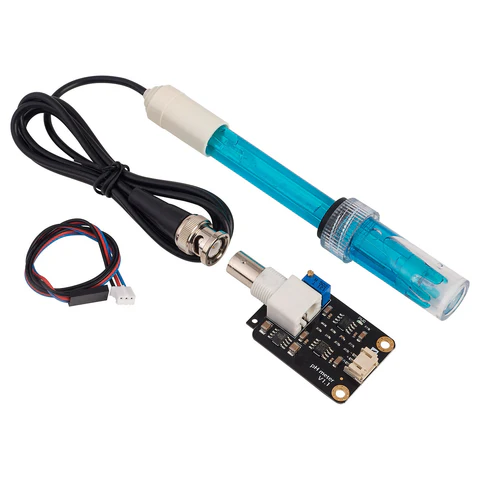#PHSensorsMarket
Explore tagged Tumblr posts
Text
pH Sensors Market Future Trends Reflect Advancements in Automation, Miniaturization, and Smart Monitoring Systems
The pH sensors market future trends are being shaped by rapid technological advancements, evolving industrial requirements, and a growing need for precision in chemical and biological measurements. As industries across sectors such as water treatment, pharmaceuticals, food and beverage, and environmental monitoring demand greater accuracy and efficiency, pH sensors are becoming smarter, more compact, and more integrated with digital ecosystems. These future trends are poised to redefine how pH measurements are used in both laboratory and field environments.

One of the most prominent trends is the integration of pH sensors with digital platforms and smart technologies. Traditional analog pH sensors are increasingly being replaced with smart digital sensors that offer real-time data transmission, self-calibration, and predictive maintenance capabilities. These digital solutions are transforming industrial monitoring by reducing downtime, improving accuracy, and enabling remote control and diagnostics. As the Internet of Things (IoT) continues to expand, smart pH sensors are expected to become a key component of connected industrial systems.
Miniaturization and portability are also gaining momentum in the pH sensors market. Compact and portable pH meters are in high demand across field-based applications, particularly in environmental testing and agricultural monitoring. Researchers and field technicians require easy-to-carry tools that deliver reliable results without bulky instrumentation. Manufacturers are responding by designing sleek, durable, and lightweight devices with built-in storage and wireless connectivity, allowing for greater mobility and faster on-site decision-making.
Another significant trend is the increased use of pH sensors in environmental sustainability initiatives. As water pollution and soil degradation become critical global concerns, real-time pH monitoring is essential in assessing the health of natural ecosystems. Governments and regulatory bodies are enforcing stricter environmental regulations, pushing industries to adopt continuous pH monitoring systems. This rising environmental consciousness is opening new opportunities for sensor deployment in wastewater treatment, aquaculture, and air quality control systems.
In the biopharmaceutical and healthcare sectors, the role of pH sensors is expanding rapidly. These industries demand stringent quality control, and pH levels often play a vital role in product consistency and safety. In pharmaceutical manufacturing, inline pH measurement is crucial for fermentation processes, bioreactor monitoring, and sterile environments. Future trends point toward sensors that can withstand aggressive cleaning protocols, offer faster response times, and provide integration with automated process control systems.
The food and beverage industry is another significant driver of future pH sensor innovations. With increased emphasis on food safety, shelf life, and taste consistency, accurate pH measurement has become an essential quality parameter. Next-generation sensors are being developed to work in high-temperature environments, with faster calibration and improved resistance to fouling. Trends also include sensors embedded in packaging or production lines for non-intrusive, continuous monitoring.
Material innovation is further enhancing sensor capabilities. Electrode technology, particularly for glass and non-glass electrodes, is evolving to meet the demands of harsh environments. Newer materials are being explored to extend the life of sensors, improve their resistance to chemical corrosion, and maintain accuracy across diverse pH ranges. Non-glass solid-state sensors are especially gaining interest in industries where glass breakage is a concern, such as food processing or medical applications.
Wireless technology and mobile integration are shaping the future of pH sensor usability. Wireless pH sensors can now connect directly to smartphones or cloud platforms, allowing users to monitor results in real-time, receive alerts, and log data for further analysis. This is particularly useful in remote operations, agricultural applications, and scenarios requiring fast, data-driven decisions. The fusion of sensors with mobile apps and cloud storage also enables better long-term data management and regulatory compliance.
The pH sensors market is also witnessing the emergence of AI-powered diagnostics. Artificial intelligence and machine learning algorithms are being developed to interpret pH data patterns, predict anomalies, and suggest corrective actions automatically. These intelligent systems can optimize operational efficiency in industrial processes, reduce human intervention, and minimize the risk of human error.
Customization and modular designs represent another future trend. Users are seeking flexible solutions that can be tailored to specific operational needs. Manufacturers are now offering modular sensor systems that can be easily adapted or upgraded, whether in terms of connectivity, calibration options, or sensor length and size. This adaptability allows companies to respond quickly to changing conditions or regulatory demands.
In conclusion, the future of the pH sensors market is marked by a shift towards smarter, more connected, and application-specific solutions. With rising demand from environmentally conscious industries, precision-focused healthcare applications, and efficiency-driven manufacturing processes, pH sensors are evolving beyond traditional laboratory instruments. Companies that invest in automation, miniaturization, material durability, and digital integration will be best positioned to lead in a market defined by innovation and adaptability.
0 notes
Link
pH sensors market is expected to gain market growth in the forecast period of 2020 to 2027. Data Bridge Market Research analyses that the market is growing with a CAGR of 7.8% in the forecast period of 2020 to 2027 and is expected to reach USD 1,723.65 million by 2027 from USD 945.15 million in 2019. Increasing demand of pH sensors in paper and pulp industry, improving monitoring of pH in food and beverage industry, technology advancement in pH sensors are the major drivers which propelled the demand of the market in the forecast period.
0 notes